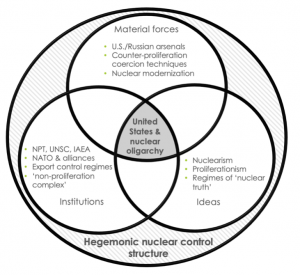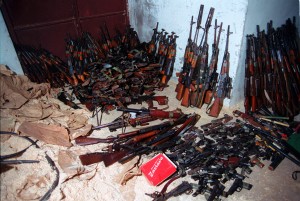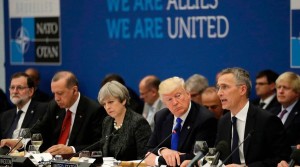 The deployment of THAAD in South Korea has resulted in considerable controversy. In a new article, Inwook Kim and Soul Park however argue that THAAD is vulnerable to readily available, relatively inexpensive, and highly effective countermeasures. They therefore suggest that the threat of retaliation should continue to be a dominant deterrence strategy.
The deployment of THAAD in South Korea has resulted in considerable controversy. In a new article, Inwook Kim and Soul Park however argue that THAAD is vulnerable to readily available, relatively inexpensive, and highly effective countermeasures. They therefore suggest that the threat of retaliation should continue to be a dominant deterrence strategy.
In July 2016, huge political controversy and diplomatic friction erupted in Northeast Asia over the United States and Republic of Korea’s announcement to deploy the Terminal High Altitude Area Defense (THAAD), a latest ballistic missile defense (BMD) system, designed to intercept short-, medium-, and intermediate-range missiles at their terminal flight stage.
Though justified as South Korea’s defensive measure against North Korea’s growing nuclear and missile threats, multitude of actors in the region opposed the deployment. They pointed out issues such as environmental concerns or intra-alliance politics, but most contentious was its possible ramifications on U.S.-China strategic balance in the region.
Unsurprisingly, a desirability of the THAAD deployment quickly became a subject of intensely politicized issues and debates, presenting significant challenges to regional politics and security.
Our recent article is motivated by this seemingly irreconcilable, complex, and consequential controversy. Rather than confronting these debates as a whole, however, we choose to focus on the two fundamental questions that underlie the debates: whether THAAD is a capable defense system, and how best to ensure South Korea’s national security against North Korea’s nuclear and missile threats.
Is THAAD’s interception capability what it promises to be? Although some are more critical than others, the conventional wisdom can be summarized as “qualified optimism,” or that THAAD is not perfect but net-positive to South Korea’s missile defense.
However, we find assumptions of this widely-shared assessment too static because it fails to properly take into account military countermeasures North Korea would be prompted to undertake in order to neutralize the new BMD system.
To address this gap, we give analytical primacy to the dynamic nature of arms race, more specifically, to the availability, cost, and effectiveness of military countermeasures North Korea can develop. Examining a variety of countermeasures against BMD systems, we find that manipulation countermeasures, those designed to exploit the THAAD’s technical vulnerabilities, are readily available, relatively inexpensive, and highly effective.
Three such countermeasures are particularly noteworthy. First, North Korea can deceive the THAAD system by making discrimination of real warheads from decoys difficult. By “mimicking the appearance of real reentry vehicle when viewed by various optical or radar sensors,” decoys have been an effective measure to confuse the radar and hence reduce a chance of successful missile interception.
Second, missiles could be turned into tumbling or spiraling in their terminal phase of flights. They make the missile flight movements erratic and unpredictable, against which THAAD and its radar is yet to demonstrate monitoring and interception capability. So far, the BMD tests have only been conducted against incoming missiles with stable and straight flights.
Third, North Korea can simply outnumber the THAAD interceptors. One THAAD battery comes with only 48 ready-to-launch interceptors and they take up to one hour to reload. It is also estimated to cost $800 million per battery. From Pyongyang’s point of view, the use of numerical superiority is an attractive option as no new technical knowledge is necessary and it imposes significantly higher cost to Seoul to maintain the numerical parity of THAAD interceptors.
In short, as missile technology decisively favors offense over defense, we find the technical and financial viability of defending North Korea’s missile threats through the construction of a missile defense system questionable at best.
Rather than to deploy the THAAD system to beef up defense capabilities, we argue that the current extended nuclear deterrence framework based on massive retaliation should continue to provide strategic stability on the Korean peninsula. In other words, a “deterrence gap” does not seem to exist against a nuclear-armed North Korea that warrants additional enhancement of defense capabilities.
In our article, we examine two key components of nuclear extended deterrence. First, the current nuclear balance and projections moving forward all remain highly favorable for the United States against regional nuclear states. As it stands, the overwhelming U.S. nuclear and conventional retaliatory capability can easily overwhelm North Korea’s small arsenal even in the most pessimistic of scenarios and without the added THAAD defense capability.
Such strategic nuclear arsenals are further supplemented with U.S. military commitment to the Asia-Pacific region at the conventional level. Thus, massive retaliation based on the current and conventional balance should serve as strong deterrence mechanism against any North Korean nuclear attacks or military provocations.
Second, extended nuclear deterrence remains a viable option as long as the U.S. remains committed to its allies against nuclear North Korea. To this end, successive American administrations in the post-Cold War era have continuously reaffirmed its security commitment to the U.S.-ROK alliance and to the maintenance of extended deterrence in East Asia. This policy stance has remained unchanged under the current Trump administration as key officials have continuously identified its alliance with South Korea as being the “lynchpin for peace and security” in the region.
Tellingly, as North Korea continued to conduct nuclear and intercontinental ballistic missile (ICBM) tests in 2017, it was the logic of massive retaliation and not the logic of denial that underpinned the Trump administration’s strategic posture. More crucially, credibility does not necessarily have to operate with 100% assuredness. Pyongyang only need to believe that the U.S. might respond to an attack for extended deterrence to remain credible. In fact, the credibility of extended nuclear deterrence has been institutionalized even further within the U.S.-ROK alliance framework as the Extended Deterrence Strategy and Consultation Group (EDSCG) was regularized under the Trump and Moon Jae-in’s administrations.
In sum, how should South Korea maintain “deterrence under nuclear asymmetry”? Given the relatively inexpensive countermeasures readily available and with the technological imbalance favoring the missile offense over the THAAD defense capabilities, the threat of retaliation against a nuclear North Korea should continue to be a dominant deterrence strategy.
However, we caution against outright rejection of THAAD’s deployment. THAAD has never been a mere technical issue but increasingly become one concerning alliance credibility. Therefore, while Seoul and Washington are ill-advised to treat THAAD as a reliable defense system, they still should evaluate its benefits and costs in the larger context of alliance credibility management.
More broadly, our article draws attention to a lack of appreciation for security dilemma among practitioners–security is a product of interactions between two or more states and therefore the optimality of weapons acquisition must be assessed with the adversary’s ability and willingness to respond.
Inwook Kim and Soul Park are respectively Assistant Professor at the Singapore Management University and Lecturer at the National University of Singapore. They recently published “Deterrence under nuclear asymmetry: THAAD and the prospects for missile defense on the Korean peninsula”, Contemporary Security Policy, Advance online publication, is available here.
 Hylke Dijktra, Editor of CSP, notes that “As we are publishing our 40th volume in 2019, this is a major recognition of four decades of scholarly work. I would like to thank all authors, reviewers and readers for the contributions they have made to the journal. This is a testament to their work.”
Hylke Dijktra, Editor of CSP, notes that “As we are publishing our 40th volume in 2019, this is a major recognition of four decades of scholarly work. I would like to thank all authors, reviewers and readers for the contributions they have made to the journal. This is a testament to their work.”






 Demobilization, Disarmament and Reintegration (DDR) programs play a central role in intrastate peace agreements. Yet DDR is often asymmetrical. Non-state actors are required to give up their weapons. The weapons of state parties, in turn, are mostly left out of these peace negotiations. Monica Herz and Victória Santos analyze in
Demobilization, Disarmament and Reintegration (DDR) programs play a central role in intrastate peace agreements. Yet DDR is often asymmetrical. Non-state actors are required to give up their weapons. The weapons of state parties, in turn, are mostly left out of these peace negotiations. Monica Herz and Victória Santos analyze in  Contemporary Security Policy is seeking proposals for a special issue to be published in 2020 (volume 41). The special issue should address a topic within the aims and scope of the journal.
Contemporary Security Policy is seeking proposals for a special issue to be published in 2020 (volume 41). The special issue should address a topic within the aims and scope of the journal.
